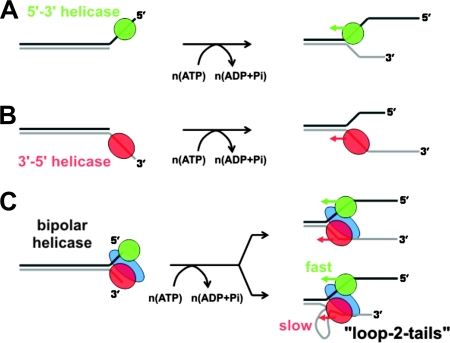FIG. 6.
Unwinding polarity of SF1 DNA helicases. (A) Unwinding of DNA by a 5′→3′ DNA helicase. The enzyme moves in a 5′→3′ direction on ssDNA. To unwind duplex DNA, the helicase first binds to a 5′ ssDNA tail neighboring the duplex and then translocates along that strand and into the duplex DNA. (B) Likewise, a 3′→5′ DNA helicase can bind to a 3′ ssDNA overhang and translocate unidirectionally toward the 5′ end and into the duplex portion of the substrate. (C) RecBCD is a bipolar DNA helicase. It contains two DNA helicase subunits of opposite polarity and can initiate unwinding from a blunt duplex end. In the initiation complex, the 3′→5′ subunit (red) binds to the 3′ side of the DNA end, and the 5′→3′ helicase (green) binds to the 5′ side. Although the translocation polarities of the two DNA motors are opposite, they move in the same overall direction on the antiparallel DNA duplex. If the two DNA motors move at unequal speeds, then the faster motor will be associated with a longer ssDNA tail, and the slower motor will be associated with an ssDNA loop and a shorter ssDNA tail. This unwinding intermediate (referred to as a “loop-2-tails” structure) has been observed by electron microscopy (see the text for details).

